A Historical Perspective
Singapore is an island, located at the southern tip of Malaysia. From 1819, it served as a trading port for British ships on their way to India. As a major trading hub and because of its close proximity to its neighbour Malaysia, Singapore was prone to many foreign influences, both from Britain and from other Asian countries. Chinese and Indian workers moved to Singapore to work at the harbour. The country remained a British colony until 1942.
Although it took several decades to turn Singapore into the industrialized nation and expat hot spot that it is today, the foreign influence on culture in Singapore remained. Today, it is estimated that just over half of the total workforce in Singapore is foreign. A mix of various languages, traditions, and religions is prevalent all over the state.
Singapore is the home of people with multiple cultures and traditions. The key inhabitation of the small island country comprises of the Malays, Chinese, Indians, and the Eurasians too. Each of these groups follow their own traditional costume as followed by their ancestors in their respective countries. Singapore thus brings forth a diversity in its ethnicity and attire.
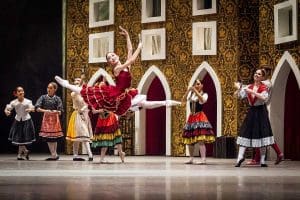
National Identity
There is no single dominant national identity. Instead, there are complex identities that draw on a variety of sources and are relevant in different situations, although ethnic identity takes precedence in most situations.
Ethnic Relations
Cultural links to India, China, Malaysia, and Indonesia give Singaporeans orientations and loyalties that stretch far beyond the national borders. These differences are superseded by an identification with Singapore as a homeland with wealth and stability. Distance and distinction mark ethnic relations within the country.
Social Stratification
Classes and Castes :
There are wide income and wealth differences, but the country is more differentiated by ethnicity than by class. All the ethnic groups have experienced upward occupational mobility. There is an intense focus on education. Good marks are a sure path to good positions with good wages. In this respect, Singapore is a meritocracy.
Symbols of Social Stratification :
Singaporeans jokingly refer to their desire for the “five C’s”: car, condominium, credit card, club membership, and career. These are important symbols of wealth and status regardless of ethnicity. There is no national costume, but the orchid is used as a national symbol, and textiles with orchid patterns may be employed as a national symbol on formal occasions.
The Culture of Singapore – Where East Meets West!
While Singapore’s physical facade goes through multiple changes constantly, there are still key identifiers in terms of identity and specifically in terms of culture that have gone unchanged. From the unique variant of English to impressive cleanliness and the plethora of fines, here’s what you should know about the island state’s culture.
Religion in Singapore – A Melting Pot of Cultures
Singapore is home to 10 religions, out of which Buddhism, Hinduism, Islam and Christianity are the primary religions, while Zoroastrianism, Judaism, Sikhism, Jainism and others form the minority cluster. The Lion City is the ultimate melting pot, with the locals celebrating all festivals pompously, irrespective of the religion they follow. It does not have a state-regulated religion which the citizens are supposed to follow. Singaporeans are free to decide and follow any religion they like. Unlike other countries, this stands absolutely true. The Singapore Religion is technically a mix of several communities.
| Religious Community | Population Percentage |
| Buddhism | 34% |
| Taoism | 10% |
| Christianity | 17% |
| Catholicism | 7% |
| Protestantism and other non-Catholic | 12% |
| Not religious | 19% |
| Islam | 14% |
| Hinduism | 5% |
| Other religions | 0.6% |
These are 5 of the main religions in Singapore.
Buddhism

Buddhism is one of the main religions in Singapore with almost 3/5th of the population are Buddhists. The form of Buddhism most prevalent here is the Chinese Mahayana. So, unsurprisingly, the largest Mahayana Buddhist temple – Kong Meng San Phor Kar See Monastery – is also situated here. It attracts millions of tourists and locals annually and a large contributor to the tourism sector.
Famous Buddhist Monasteries in Singapore: Buddha Tooth Relic Temple, Wat Ananda Metyrama, Lian Shan Shuang Lin Monastery.
Taoism

Taoism is another major religion in Singapore. Taoism was born out of the preaching of a very famous Chinese philosopher, Lao Tzu. According to him, the true way of leading life is by honouring our ancestors and being compassionate towards the earlier generations. He was also the propagator of the yin and yang theory.
Famous Taoist Temples in Singapore: Thian Hock Keng Temple (the oldest Taoist temples in the world), Ang Chee Sia Ong Temple, Fuk Tak Chi Temple, Hong San See Temple, Tan Si Chong Su Temple, Tou Mu Kung Temple, Yueh Hai Ching Temple.
Islam
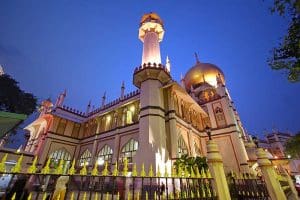
The religion is Islam is not a very prominent religion in Singapore. Although you will still find a lot of Muslims here. Roughly 14 per cent are followers of this religion
The Majlis Ugama Islam Singapore or MUIS is the primary body responsible for protecting and improvising on the social, cultural and religious needs of the Muslims of Singapore. They also take care of the mosques and other monuments around the country. They are also very involved in organising a yearly pilgrimage to Mecca. One of the most prominent figures of the Islamic world is Mr Yusof Bin Ishak. He is also widely recognised as the first President of Singapore has a portrait of him imprinted on all the currency notes valid here.
Famous Mosques in Singapore: Masjid Sultan, Abdul Gafoor Mosque, Masjid Al-Islah Masjid Assyafaah, Hajjah Fatimah Mosque, Masjid Maarof, Masjid Al-Ansar.
Hinduism

Eminent deities worshipped by the Hindus in the world and Singapore alike include Ganesha, Lakshmi, Parvati, Rama, Durga, Krishna and Hanuman to name a few. Hindus occupy more than 5% of the entire population.
The oldest Hindu temple also is known by the name of Mariamman Temple is located here. Local Hindus and people from all over the world come to Singapore to visit this temple. It attracts millions of tourists annually and very famous among the Singaporeans. There are a total of 30 Hindu temples in Singapore. All these temples, as well as the social-cultural and religious rights, are protected and managed by the Hindu Advisory Board and Hindu Endowments Board.
Famous Hindu Temples in Singapore: Sri Mariamman Temple, Sri Veeramakaliamman Temple, Sri Srinivasa Perumal Temple, Sri Thendayuthapani Temple, Sri Senpaga Vinayagar Temple, Sri Sivan Temple.
Christianity
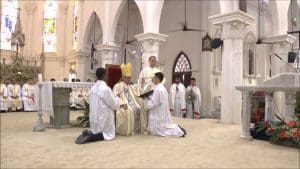 The oldest Christian Church also known as the Armenian Church is situated here. It was built in the 1830s and is quite popular amongst Christians all over the world. It is flanked by millions of people from all over the world and Singapore alike.
The oldest Christian Church also known as the Armenian Church is situated here. It was built in the 1830s and is quite popular amongst Christians all over the world. It is flanked by millions of people from all over the world and Singapore alike.
Christianity has sects such as Protestants and Catholics. Churches catering to both these sects are located here. There are around 30 Catholic churches spread across the country and as many or more Protestant churches as well.
Famous Churches in Singapore: St. Andrew’s Cathedral, St Joseph’s Church, Church of St. Teresa, Church of the Nativity of the Blessed Virgin Mary, Cathedral of the Good Shepherd, Church of St. Alphonsus, Our Lady of Lourdes.
Religious Festivals in Singapore
What happens when you have a mixed bag of religions and culture come together? You get Singapore! With 5 very prominent religions in Singapore, the religious traditions and festivals are quadrupled. With festivals happening everywhere, here’s a list of the most auspicious religious festivals in Singapore that you keep a keen eye out for when you visit the city.
The non-religious community of Singapore
The Singapore Religion of being non-religious is becoming popular. The non-religious community of Singapore is just as diverse as the religious community, constituting about 18.5% of the population of Singapore. They form ethnic groups and identify themselves as atheists, agnostics, free thinkers, humanists, sceptics, etc. Some of them are theists as well, practising the rituals but denying the affiliation to any religion. It is interesting to note that the community is expanding massively and the gatherings of the non-religious community are getting mainstream. One such famous Meetup is the Singapore Humanism Meetup consisting of over 400 secular humanists. Groups like Humanist Group are gaining popularity and being gazetted as a society on a national level. Also, these groups link to other non-religious groups in Southeast Asia.
Languages of Singapore
The official language of Singapore is Malay while there are four commonly used languages in Singapore: English, Malay, Mandarin Chinese and Tamil. English is the most widely spoken language (primarily by the population below the age of 50), and the medium of instructions in school. English is also the language of business and government in Singapore, based on British English.
| Language | Percentage |
| English | 37% |
| Mandarin | 35% |
| Chinese Dialects | 13% |
| Malay | 10% |
| Tamil | 3% |
| Others | 2% |
A unique and widely spoken language in Singapore is the Singlish. It is primarily the colloquial form of English, having a distinct accent, and ignoring the basic standards of English grammar. Having a jumble of local slang and expressions of various languages and dialects of Singapore, speaking in Singlish is seen as a mark of being truly local! Interestingly, all the schools in the city teach the language of the child’s parentage, along with English, to ensure the child stay in touch with the traditional roots.
- Malay in Singapore
The standardised version of the Malay language in Singapore is Bahasa Melayu, spoken by nearly 13 per cent of the Singaporean population. One of the official languages, Malay was once the national language of Singapore before the advent of the British in 1819. The Singaporean Malay is written in the Roman script known as Rumi. In the earlier days, it was written in Jawi script which was based on Arabic. The national anthem of Singapore – ‘Majulah Singapura’, or Onward Singapore – is also written in Malay. Malay language in Singapore is taught in schools, with the Rumi, as well as, the Jawi script taught to the beginners.
- English in Singapore
One of the most common Singapore languages is English, a medium of instruction in schools and the official language of business and government. Being a former Crown Colony, the English used in Singapore is based on the British conventions. The idea behind promoting English was to serve a unifying factor for the multi-cultural ethnic group to have a standard dialect to communicate in. English as a major language in Singapore also helps the country to grow and prosper in various fields at the international level. A steep rise in the percentage of the English-speaking population has made Singapore as the leading country in Asia with maximum English speakers. Although a whopping 32 per cent of the Singaporean population speaks English, it has been found that English is their second language.
- Mandarin in Singapore
Huayu or Mandarin is the official Chinese dialect spoken in Singapore. People here use simplified Chinese words mostly borrowed from Hokkien, Teochew, Cantonese, and Hainanese dialects. Mandarin is the official mother tongue for the Chinese Singaporeans. With the growing usage of English, the use of Mandarin language in Singapore has witnessed a decline in the recent year, but the Singaporean government has been promoting it as the primary link to the Chinese culture and tradition. There was even a time when the other Chinese dialects were banned from different media channels, and Mandarin was the only popular choice as a medium of education in schools.
- Tamil in Singapore
It might sound astounding but believe it when we say that 9.2 per cent of the Singaporean population were Indians, according to the population census in 2010. It was also found out that approximately 76.7 per cent of these Indians spoke Tamil as their native language. Hence, Tamil was selected as an official language of Singapore after a significant population of Indians from the state of Tamil Nadu region moved here. The other Indian languages spoken by the minorities in Singapore include Kannada, Telugu, Punjabi, Sindhi, Hindi, Malayalam and Gujarati.
- Singlish in Singapore
Now Singlish sounds new to your ears, doesn’t it? Singlish is Singaporean’s very unique take on English with words borrowed from Hokkien, Tamil and Malay. Do not expect the standardised grammar or a decent accent – it is more like a colloquial form of English with a vast vocabulary contributed by all the local dialects spoken. This fun Singapore language is mostly broken words. Hence, do not even get the idea of drafting a formal mail to your boss in Singlish. The language has distinct phonology with which the true Singaporeans associate themselves as their unique identity.
Singapore’s Cuisine Food haven
Having a reputation as a food haven, it’s no wonder this is such a big part of the local culture. The inter-mingling of various ethnicities and groups has created fusions and unique delicacies that will make anyone’s mouth water. Besides the infamous chicken rice, roti prata and nasi lemak that everyone knows Singapore by, locals also love the infamous durian – be prepared to have your noses tickled by the pungent stench when it’s durian season. If you need a quick and easy primer for local food in all its varieties, just visit the closest hawker centre and have your pick.
The national pastime of the people of Singapore is eating! From Michelin-starred restaurants to cheap hawker centres, Singaporeans are obsessive gourmands who love to makan (“eat” in Malay). Being a true cosmopolitan, the cuisine of the Lion City is one of the world’s most diverse and piquant. Hawker centres, coffee shops (kopitiams) and food court dominate the scene, serving palatable food at pocket-friendly prices. For the lovers of luxury, there is no dearth of celebrated restaurants in Singapore. One will find quality Chinese, Malay, Indian, Japanese, Thai, Italian, French, American and other food in this city-state.
The most identifiable cuisine in Singapore is Peranakan or Nonya cuisine, a unique fusion of Chinese and Malay cooking styles prepared by the Peranakan community. Chilli crab; Satay with peanut sauce, onions and cucumber; Katong laksa (white noodles in a creamy, immensely rich coconut-based curry broth, topped with cockles or shrimp) with chilli paste and chopped laksa leaf in a spoon are some of the most popular local delicacies of Singapore.
Hawker centres
No doubt, food and drink are the key unifiers for all residents on the little red dot, which is why the humdrum hawker centres have such a prominent presence around Singapore. It is constantly packed day and night, the centre of gossip and revelry and the perfect place to have a taste of the local cuisine at affordable prices. The best way to describe the hawker centre is that it is a cross between a Western bar and a community centre, where people hang out, eat and engage in boisterous conversations.
Festivals of Singapore
The culture of Singapore is highly influenced by a large number of religious festivities taking place all around the year. August 9 is the country’s Independence Day, which is celebrated with the National Day Parade since 2005. Other than this, the public holiday list of Singapore is a reflection of the country’s racial, religious and linguistic diversity. Among the assured ones, there is Chinese New Year, Eid-ul-Fitr, Diwali and Buddhist Vesak Day or the Death of Buddha, as well as Good Friday, Christmas and New Year’s Day. Other celebrated festivals are Pongal, Thaipusam, Buddha Jayanti and Hari Raya Haji.
Among cultural festivals, there is Singapore Food Festival every year from June-end to July-end, Singapore Art Festival every January, and Singapore Night Festival which comes alive with different themes every year for two weekends in August, at Bras Basah Bugis art enclave. The Buddhists celebrate Hungry Ghost Festival and offer eatables to the spirits of their deceased. Between May and June, the Dragon Boat Festival or the Zhongxao Festival in Chinese takes place at Bedok Reservoir, where dragon-shaped boats oared by a dozen or so people aside, compete in the race. Mid-Autumn Festival or the Lantern Festival is one of the largest celebrations in the country, which marks the 15th and the last day of Chinese New Year festivities. The sky of Singapore gets covered with flaming dots of paper lanterns set free.
Singapore’s Folk Dance and Music
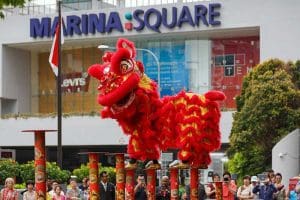 The range of dance comprising traditional, as well as contemporary, is a reflection of the diversity of the culture in Singapore. Predominated by the Chinese community, the island population also consists of Indians, Malays and Indonesians highlighting Singapore as a multicultural country. Lion Dance by the Chinese community is performed during various festivities like New Year while the Malay National Dance – Zapin – is popular among Malays. One can even find Indian Bharatanatyam and Kathak been taught in multiple schools in Singapore. Undoubtedly, this is one of the best places to experience western-style performing arts including Opera and Ballet with the courtesy of Symphony Orchestra at Esplanade-Theatres on the Bay which offers free jazz and opera performances occasionally by the water’s edge. The island is also known to host a range of music festivals like Mosaic Music Festival and the cutting edge Baybeats every year attracting various international stars and rock bands from overseas.
The range of dance comprising traditional, as well as contemporary, is a reflection of the diversity of the culture in Singapore. Predominated by the Chinese community, the island population also consists of Indians, Malays and Indonesians highlighting Singapore as a multicultural country. Lion Dance by the Chinese community is performed during various festivities like New Year while the Malay National Dance – Zapin – is popular among Malays. One can even find Indian Bharatanatyam and Kathak been taught in multiple schools in Singapore. Undoubtedly, this is one of the best places to experience western-style performing arts including Opera and Ballet with the courtesy of Symphony Orchestra at Esplanade-Theatres on the Bay which offers free jazz and opera performances occasionally by the water’s edge. The island is also known to host a range of music festivals like Mosaic Music Festival and the cutting edge Baybeats every year attracting various international stars and rock bands from overseas.
Arts and Crafts in Singapore
There are a number of museums, art galleries and musical orchestras to celebrate the artistic culture of Singapore. National Gallery Singapore is the flagship museum with more than 8,000 works of South Asian artists. Other important names are Singapore Art Museum which focuses on contemporary art and Red Dot Museum with its love for paintings of mundane, everyday objects.
In music, Singaporeans love folk, pop, rock and classical. The musical scene is spearheaded by Singapore Symphony Orchestra, established in 1979, with its chief venue at Esplanade Concert Hall. The Esplanade- Theatres on the Bay is the nation’s largest platform for the celebration of performing arts.
Architecture in Singapore
If there’s one thing any traveller swears by, it is Singapore’s iconic skyline. A visit to the Lion City is incomplete without marvelling at the many architectural delights found in every corner, from seventeenth-century shophouses to futuristic glass facades. Be it a history buff, an avid tourist, a curious local, a building enthusiast or even an Instagram-loving influencer, the architecture in Singapore is stunning enough to please every aesthetic.
The strategic location of the country, diversity of population, eventful history and intermingling cultures and ethnicities have contributed to a range of styles and structures, lending stark juxtapositions of contrasting architecture. Go through our curated list of the most significant buildings that are a must-visit in this iconic city, and get those ‘gram-worthy shots!
Precolonial Style
Before modern Singapore was ‘discovered’ by the British, the mainly Malay inhabitants of the fishing villages built houses within ‘kampongs’ (villages) with hardwood beams, palm front ceilings, bamboo walls, and stilts. While no authentic houses from this period remain, the sites of these villages are available at Punggol Waterway Park’s heritage walkway where paintings and recreations of these bamboo houses are up for display.
Colonial Period
After Sir Stamford Raffles landed in the Lion City in 1822, he laid the foundation for modern Singapore and brought British rule to the region. During this time, prominent European styles of architecture emerged and made up the skyline of this British colony.
The best examples of its architecture are National Gallery, CHIJMES, Old Hill Street Police Station, Shophouses, OCBC Building, Parkview Square Building, Jewel Changi Airport, Helix Bridge, Gardens by the Bay, Esplanade – Theatres on the Bay, Marina Bay Sands, ArtScience Museum, Henderson Waves, etc.
HDB
Short for the Housing Development Board, HDB blocks are found dotted across the island, sometimes new ones are constructed and old ones torn down. They come in various shades, designs and shapes, but one thing that is key to understanding this is how much of the relationship between Singaporeans and the multi-cultural society is influenced by HDBs. For a small island with limited space, HDB blocks pack a lot of people in, creating this suburban environment that allows a communal space for people to interact with each other and build ties that constantly forges the Singaporean identity.
Education
For a city state with little resources, education has become instrumental for the citizens to have a future. Singaporeans hold the idea of learning very highly, with parents sending kids to supplementary training classes very early on to ensure their kids make it to the best schools. It is a draining and competitive environment for the world’s most expensive city so it’s no wonder that the idea of a lack of education will hold you back has such strong cultural impact and influence here.
Garden city
Singapore as a city state does not exactly resemble a concrete jungle at all unlike other cities. One thing you will notice when arriving in Singapore is how much greenery there is. This is useful for a nation that lies on the equator, as the trees and shrubbery help in reducing the heat, albeit slightly. This has created a unique environment where urban designs meet nature and allow for a healthier and less polluted megalopolis to function. The amalgamation has also allowed Singapore to preserve much of its nature even with the constantly changing and developing landscape.
Fine city
Probably the most important bit of information for tourists but a tedium for the locals is that you should be careful with what you do and where you do it. Singapore is notorious as a city that loves giving out fines. You can’t chew gum or smoke anywhere you like. Instead, you have to constantly look out for spots where you can indulge in your habit legally and without repercussion. Littering carries a fine as well so don’t throw that wrapper just anywhere.
Nightlife
For a city that works hard, it parties hard as well. Clubs here open till the wee hours for night revellers and party animals to unwind. For the more relaxed and frenetic, there are also bars that litter the central hubs like Boat Quay and Clarke Quay. Supermarkets and fast food chains are commonly open for 24 hours and even the hawker centres close their shutters very late. Night time is not considered very dangerous here, so expect to see people buzzing about till late.
Cleanliness
For a crowded city in a small space in an extremely humid environment, you will notice how clean the city is. Dustbins are a common sight and an effective waste disposal program has meant the city streets are spick and span. As warned, littering carries a fine, so there’e a deterrent for people not to flippantly throw away their food packets or napkins, but there is also a strong sense of etiquette by Singaporeans to keep rubbish off the streets. Interesting tidbit: besides a fine, one of the most popular ways to punish offenders who litter is to make them do community programs to sweep the streets.
Always shopping
Besides the Great Singapore Sale (GSS) being an annual celebration of discounts and gifts with purchase, Singapore is a city where people are always shopping or looking for the best bargain. Walk about any HDB estate and on the weekends, you will see street hawkers peddling their discounted wares which can include anything from clothes to fans to new iteration of the common broom. Singapore has plenty of malls too, which even outside the major sale periods have some promotions. Singapore and bargains go hand in glove always.
Queuing
Lastly and most importantly, learn to queue, and possibly for a long time. Queuing has become a national pastime here. With a large population always on the move, you will see lines forming for the next iPhone, public transport or stuffed cuddly toys. Singapore has a reputation for organisation and order and it’s no wonder that in so many things, queuing has become such a big thing. Even walking on the escalator, you will see a line forming on the left while the right hand side is for those in a rush. This can be seen as a welcome delight considering the rather hectic pace at which Singapore runs and yet people can be so patient to queue.
Singapore’s Customs & Traditions
One cannot put his/her chopsticks in an upright position while having food as doing so can cause him some glares from the people around because the only time Singaporeans put their chopsticks upright is during funerals.
Taking off his/her shoes before entering a house including temples and mosques.
Not bringing dogs near their Muslim friends as they consider dogs to be unclean.
Bringing along food and flowers to Hindu or Buddhist temples as an offering for the gods.
The culture in Singapore is a celebration of diversity in all its elements and the neighbourhoods like Little India, Chinatown and Tiong Bahru are the burning illustrations of that. On the surface, everything is quintessentially Singaporean. But once you dig deep, it is evident how different heritages have comfortably merged and mingled with each other to create what the world sees as the true culture of Singapore.
The complete history of Fashion in Singapore: A Story of Style through the Ages
Think of Singapore and a canvas of rich, vibrant images springs to mind. A melting pot of cultures, beliefs and traditions, it’s this ethnic diversity that gives the country its multi-faceted universal appeal. Nowhere is this eclectic blend more visible than in the fashion landscape of what has fast become the fashion capital of South-East Asia.
East meets West in Singapore
Changing Fashion Reflects a Changing Society
Over the course of those fifty years, fashion within the country has transformed greatly along with the changing times. From the late 1950s to the present, we explore the changing face of fashion in Singapore:
Finding Its Feet in the Fifties – 1950s
Prior to Singapore gaining its full independence in 1965, the country fell under Malaysian rule and, in a broader context, the colonial rule of Great Britain. World War II came to an end in 1945 and, for several years thereafter, many countries struggled to rebuild themselves to their former glory. Singapore was no different. Dressing up in the latest styles was a luxury only afforded to the wealthy classes. The Straits Chinese, for example, were more exposed to Western culture and their clothing reflected it. This class consisted largely of Indian and Chinese business owners. Given their wealth, they had easier access to literature and education from the West, and soon adopted a more Westernised manner of living. Men dressed in formal white shirts and ties, pants, a coat and leather shoes.

A Straits Chinese family
The majority of people though were engulfed in poverty and still dressed in traditional clothing displaying their heritage – Malay, Chinese and Indian.
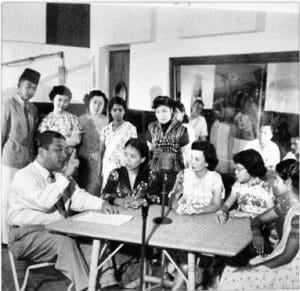
The city’s broad range of ethnicities can be seen in this picture from 1952 taken at Radio Malaya
When it came to women’s styles, fashion made as big a jump in their wardrobes as it did in their rights. In 1948, women were allowed to vote and, by 1959, eight women were running for public office. Amongst other things, family planning was introduced in 1948 and in 1961, the Women’s Charter was voted into legislation.
Similarly, huge strides were being made in fashion with Singapore becoming a hub for textiles in the region. The rise of the High Street as well as Arab Street now meant that women could buy Western-influenced clothing at affordable prices, with fabrics imported from America, Europe and the rest of Asia.
The biggest change came in the style of women’s dresses. Instead of shapeless traditional wear, women in Singapore now preferred form-fitting dresses which showed off their feminine figures. It became high fashion to mix and match Western items with traditional pieces, adding a unique identity to whomever wore them. Also, as women were no longer confined to the home, they interacted with people from other cultures, creating an eclectic fusion of styles and designs.



A model wears a more form-fitting dress, as seen here at a fashion show at Straits Times Studio in 1959
Swinging into Style in the Sixties – 1960s
The year 1965 marked the independence of Singapore. To motivate the citizens, the government made a concerted effort to encourage the working class to dress with style and purpose. The aim was for the workers to reflect the growth of the economy. Smart, Western styles were the order of the day. Traditional wear became reserved for diplomatic occasions and ceremonies. Conventional styles also received a Western make-over. A good example is the classic Chinese dress or cheongsam, also known as the qipao. Where it was once baggy in shape, ankle-length and with a high collar, the updated version became more form-fitting, including a slit on either side of the leg.
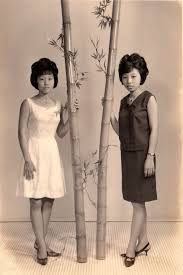
The classic cheongsam
Perhaps the biggest change during this decade was the creation of a proudly Singaporean dress style. Prior to independence, there was no sense of national identity. The immigrants that made up the country each dressed according to the style of their homeland. With freedom and independence came a more eclectic style made up of different cultures merged into a new, unique fashion.
Across the waters in the United States and the United Kingdom, the hippie movement was taking over at this time along with its bright, colourful styles. In Singapore, the government took stringent measures to prevent this influence from reaching its shores, particularly the carefree lifestyle it promoted. Boys with long hair who were dressed in hippie fashion were even picked up by police. Realizing the popularity of youth culture in global trends though, retailers started catering specifically for young people in the Sixties, even in conservative Singapore. Stores like Trend boutique opened for the first time, targeted directly at young customers.

Singapore youth during the 1960s
In spite of the anti-yellow culture movement in Singapore though, parts of Western culture still managed to infiltrate Singaporean society. An example of this is sports culture. With greater Western influence, came exposure to global sports as well as its fashion – culottes, shorts and even swimwear made their way into Singapore style.
Fashion was really exciting in the 1960s. That was when Western fashion was reintroduced to Singapore. Later, traditional clothing started adopting these designs.
For the ladies, the dresses were usually fastened with a zip at the back and had thin waistlines. Sleeveless designs were also popular. Those belonging to a higher social status such as highly educated women from well to do families, wore sleeveless cheongsams to represent both wealth and status.
Loud styles which include collarless jackets and pants that flared over boots were a common sight for men to dress up then. Loose-fitting shirts that are vividly printed and trousers with flares are the go-to for them. Long hair for men was frowned upon due to the association with hippies and drug usage.
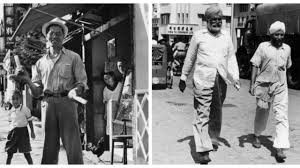
Sky-high Style in the Seventies – 1970s

With the 1965 independence, came the breakup of Malaysian-Singapore Airways which became the newly-minted Singapore Airlines. This new airline required a whole new look and French fashion designer Pierre Balmain was called in to create a new uniform for its cabin crew in 1972. What transpired was an update on the traditional kebaya which infused the traditional Malay sarong with batik in bright colours. What was not expected was the popularity of this style among ordinary Singapore women, becoming somewhat of a national costume. With its hourglass shape, the kebaya had three-quarter sleeves hemmed in a printed border. The sarong was worn underneath which fit snugly as a wrap skirt. This image of the “Singapore Girl” has become so popular, she even received her own wax figure in London’s Madame Tussaud’s Wax Museum in 1994.
The Seventies also saw the launch of jeans culture in Singapore as global brands Levis, Lee Cooper and Wrangler entered the market.


From Malaysian-Singapore Airways.. …to Singapore Airlines

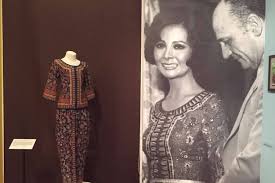 Pierre Balmain with his new design
Pierre Balmain with his new design
The first Singapore Airlines sarong kebaya uniforms, designed by Pierre Balmain in 1968.
Fashion Goes Global in the Eighties – 1980s
During the Eighties, the government began to expand its business ventures and realised the financial benefit that fashion could bring the country. The Singapore Trade Development Board (TDB) had invited designers and clothing manufacturers to exhibit their works in Paris. This resulted in Singapore Apparel, a big-scale fashion show arranged by the government and the TDB. Shopping malls also came into being, where international brands were sold alongside up-and-coming Singaporean designers. Orchard Street became known as a shopping district for tourists. Local designers also took fashion out of the country and built up a global audience. Singapore had well and truly entered the fashion market.

High fashion tailored for the office, as seen in Her World magazine, Singapore in 1987
Singapore is exposed to more pop culture with the advancement of technology in the 1980s. Bold styles and colours that were influenced by the fashion sensibilities of stars on television were often emulated by the youth.

C.K. Tangs, one of the first department stores to open on Orchard Road
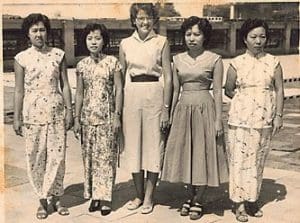
The popular fashion of the 1980s saw an increased desire for miniskirts, beaded necklaces and polka dots for the women. Bold accessories coupled with glitter makeup and daring colours started to make waves as this era was all about the bright colours.
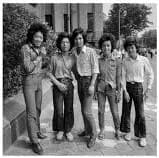
Men paid more attention to hairstyles where big bulging hair and meticulously trimmed sideburns are the trends in the 1980s. Some would even adopt the bandana to complement shirt designs with geometric prints and puffed sleeves.
National Pride during the Nineties – 1990s
The miniskirt was high fashion during the Nineties, as well as casual, comfortable clothing like Bermuda shorts. The growth of computer technology now also meant that Singaporeans were up to date on global fashion trends, and not as outdated as before. It also gave rise to designers celebrating Singaporean heritage. An example of this is the “orchid” style of the early Nineties. Designers created clothing adorned in this indigenous flower – a sign of national pride. Today, these bright, floral styles have become synonymous with Singapore’s identity globally.
In 1994, the first Great Singapore Sale took place. Aimed at locals and tourists alike, this annual shopping event has been going ever since.

Prince William and the Duchess of Cambridge, wearing an orchid-inspired dress, at the Singapore Botanical Gardens
A typical female look in the 90s included rebonded flat hair with highlight streaks along with statement belts. Taking inspiration from famous pop idols back then, they usually pair their top with a vest or just with a tube top.

Chains attached to wallets can be seen everywhere and that is a common sight among the young adults and teenagers. Chunky sneakers also made its mark then, with Nike SB and Dunk shoes taking over the streets.
Gentlemen started to abandon the puffy hairstyles and adopted the centre part. Bermuda shorts, It was adopted to suit the humid weather here in Singapore and provides men with an alternative to dressing casually. Cargo pants began to enter the fashion scene and bell-bottom jeans were a common sight for many, a throwback from the 70s. Tight-fit tees with big logos of bands and famous icons rule the streets back then.
2000s In Singapore
Fashion in the 2000s infuses elements of all the past years combined. Cropped tops and oversized tees are trends that are adopted due to celebrities popularising them. You could blame the weather in Singapore as a form of deterrent for us to explore further options such as fur coats and trench coats.
 Wristbands for various causes such as Livestrong made its mark, where support for cancer-stricken patients were shown by donning them. The popular yellow band was once considered a fashion accessory for the masses. Surfer brands such as Billabong and Quicksilver also began to make waves in the early 2000s where accessories from such brands were a common sight for many.
Wristbands for various causes such as Livestrong made its mark, where support for cancer-stricken patients were shown by donning them. The popular yellow band was once considered a fashion accessory for the masses. Surfer brands such as Billabong and Quicksilver also began to make waves in the early 2000s where accessories from such brands were a common sight for many.

Singaporeans also started to embrace the streetwear culture of recent times. Streetwear brands such as Off-White and Champion became a staple for most when they dress. Sneakers have also reached mainstream popularity where everyone owned one by internationally recognised brands.
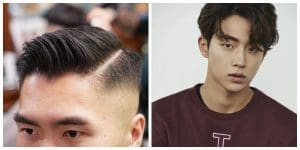
The classic cut that most males had would be the “Gentlemen Look” where the sides are faded and tapered, with the hair being combed over to one side. In recent times though, riding on the Korean Wave, some have adopted the shaggy hairdo, bangs and a centre part style that looks a little just like the 90s.
It seems as though fashion now incorporates a little from each generation. As they say, fashion never dies. It is indeed true as we see certain trends returning at certain points and it changes how we dress in public. Furthermore, in such a cosmopolitan city like Singapore, there will always be a blend of different cultures. I guess the modernised looks still take influences from the past, and no trend ever truly dies out.
The Future of Fashion
Considering the great strides that the fashion industry in Singapore has made over the past few years, it’s no wonder that fashion has emerged as a burgeoning growth market. According to the Singapore Tourism Board, in the year 2000, tourists in the country doled out a whopping SGD2.5 billion on shopping alone. Of that amount, SGD1.07 billion was spent on fashion goods like clothing, shoes, jewellery, perfume and cosmetics. Cut to 2015 and that number has exponentially increased. In 2015, spending by international visitors in Singapore has already reached US $14.65 billion, says market research firm Statista. Just look at the growing popularity of fashion-focused events like Singapore Fashion Week. In 2013, attendance figures averaged at over 20, 000 visitors. This year, with the event already in its ninth instalment, numbers sky-rocketed even beyond that, no doubt attracted by the likes of celebrity designers Diane von Füstenberg and Victoria Beckham who opened and closed the event respectively. With its unique blend of old meets new, it’s clear that Singapore has its eye firmly fixed on fashion.
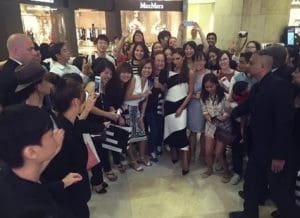
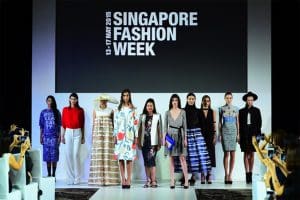
Victoria Beckham at Singapore Fashion Week 2015
Presently, Traditional Dresses of Singapore That Portray Singapore’s Diversity
Being a small island nation, Singapore inculcates people of four ethnicities majorly. These are ethnic Chinese, Malays, ethnic Indians and a small number of Eurasians. Though being a small country/city, Singapore is multiracial as well as multicultural which makes it the reason why it is home to a diverse range of ethnic wears which helps in defining the city’s culture. So, let’s dive into the culture of the residents and take an in-depth look at the traditional dress of Singapore.
Here are five traditional dresses of Singapore that represent the country’s rich diversity.
- Cheongsam
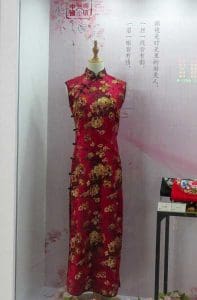
The exquisiteness of this elegant traditional Singapore costume makes it a great alternative to modern wear. Having a slim fit and appropriate cuts for comfort, one-piece dress, with a high collar made from silk or cotton, the Chinese Cheongsam or Qipao portrays the duality of modern wear as well as revives the traditional culture and identity. The High skirt offers an elegant look with artistic embroideries in satin or coloured fabrics. There are variations in the design varying from knee length to slit side. The neckline represents sophisticated behaviour and grandeur.
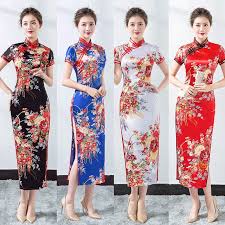
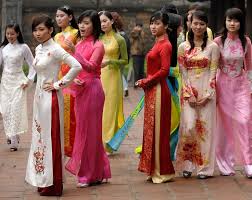
This costume comes from China and is preferred by Chinese-born women in Singapore. The cheongsam is appeared from the Qing dynasty, which was worn by the females, with its hugging design and elaborately decorated neckline. In addition, the skirt body is high cut combined with high heels make the perfect choice for women.
Cheongsam has been widely popular overseas as well as in mainland China for over 80 long years since its development in China during the early Republican times. Later on, cultural migrations resulted in the spread of this traditional attire in Hong- Kong, Shanghai, where Chinese women adapted it. Slowly, the women of Singapore and Malaya too changed it since they found the Cheongsam the perfect wear for the tropical climate there.
In South-East Asia, this traditional dress of Singapore is considered as an alternative to fashionable and modern garments. Well-tailored and exotic fabricated Cheongsams can cost as high as current high-end designer gears. Moreover, it is believed that Cheongsam too showcases a person’s cultural identity, social status and personality, due to which it was the only dress worn as a uniform by wealthy society matrons. Not only them but famous personalities like Aw Cheng Hu, Christina Loke and Elizabeth Choy has a diverse and priceless collection of Cheongsams which blended with their classy and modern persona.
- Baju Kurung


Baju Kurung is a traditional Singapore costume as well as the national dress of Malaysia, though the people of Indonesia, Singapore and Thailand have adapted with it well. It is also the national dress of Singapore. This traditional costume became fashionable in the late 19th century by Sultan Abu Bakar of Johar. Baju Kurung is a generic name given to the outfit for both male and female.
The male costume is recognised as Baju Melayu and the female version as Baju Kurung. Moreover, the Baju Kurung has two distinct fashion methodology, the Baju Kurung Teluk Belanga and the Baju Kurung Cekak Musak.
These two can be differentiated only based on a standing collar on the neck of the outfit, the former one having no collar.


The structure of the outfit consists of a large dress or sarong that stretches from hips to heels. They combine it with a long dress to the hip or knee. The design of this dress and skirt is simple, the colors are as elegant as the design of Islam.
This female traditional dress of Singapore became eminent and was adapted by an increasing number of women of Chinese, Indian as well as Eurasian ethnicity when the Baju Kurung became a uniform for the civil servants as well as female school students. Buju Kurung too like the Baju Melayu is a baggy full-length outfit which is paired with a long skirt (usually made from a long piece of cloth with folds on one side) and a collarless blouse with long sleeves which extends down to the hips or sometimes even knees. In more conservative states like Northern Malaysia, the Baju Kurung is worn with a headscarf (tudung). Malay women who work in office wear the Baju Kurung usually on Fridays to show a sign of respect for the traditional costume.
Nyonya Kebaya
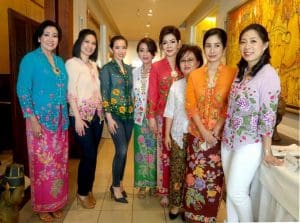
According to documents left behind, Peranakans today are Chinese, or Baba-Nyonya, descendants of Chinese immigrants to Penang as well as Malacca and Singapore in the last century. Therefore, the main language of this group is Chinese-Malay.
In addition to preserving the characteristics of ancestors, the Peranakan community has established itself with a distinct identity in food, clothing, rituals, crafts and culture. Most Peranakan Chinese are not Muslims, but follow ancestor worship, and Chinese religion.
With the arrival of British colonialists, the Peranakans also quickly adapted to the new historical context, they learned English and spoke English very well. Today, they maintain both languages in harmony with a dynamic and rich Singaporean.
A ‘Kebaya’ is a beautiful, gure-hugging traditional embroidered blouse (or dress) usually worn with a batik or sarong that is usually hand drawn, stamped or printed dyed with various motifs and in bright colors.
‘Peranakan’ means ‘Child of local descent’. This refer to the children of the early settlers (Chinese, Indians, and Portuguese) who were likely to have taken local Malay wives.
The word ‘Peranakan’ is automatically refer to the Chinese Peranakans, known as ‘Baba & Nyonya’ since it is the largest community of Peranakans. Their common trait is that their womenfolk are traditionally all dressed in the ‘Baju Panjang’ and Sarong.
The ‘Peranakan Kebaya’ (Kebaya Peranakan or Kebaya Encim) is made from a sheer material, cotton voile or silk adored with embroideries. The Kebaya embroideries are sewn with combination cutwork. The intricate embroidery work usually takes weeks even months to complete it. These Kebaya embroideries are usually worn with sarong or batik.
When immigrating to Singapore, they still keep Nyonya Kebaya costume of their ancestors. Then Nyonya Kebaya became the Singaporean costumes. According to the researchers, “Nonya” is an ancient Malay word used to show respect and love for women in high lever of society. So, to this day, Nyonya Kebaya attires to the glory of Asian women.
Nyonya Kebaya consists of a skirt and a long dress. In which the garment is trimmed sewing suits to embrace the Singaporean woman. Nyonya Kebaya is handmade costume which is in a very sophisticated and meticulous manner. This costume is worn on special occasions such as weddings, festivals … Today, Nyonya Kebaya is innovative by young people when combined with jeans or pants. Short skirts for more widespread use in daily life such as walking on the street or at work.
Baju Kebaya


Baju Kebaya is similar in style to Baju Kurung, including a long skirt and a long dress. But the long dress in Singapore’s traditional dress is more elaborately decorated. The dress is decorated with patterns to embellish the dainty of the girl. The shirt is also tight and the wearer usually wears an extra layer of underwear. The dress of this outfit is similar to a sarong and is more elaborately decorated than Baju Kurung. The skirt is made of batik pattern fabric.
- Baju Melayu

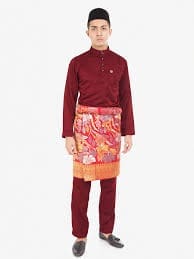
Baju Melayu, the male version of Baju Kurung, is a baggy shirt with long sleeves and is worn with long trousers. Usually, a Sampin/ Sampan (three quarter or even full sarong style garment crafted with the traditional pattern of woven materials like Kain Songket or Tenun Pahang Diraja) goes with this traditional dress of Singapore which is wrapped around the mid-body section from the stomach area, and it goes down to the knee or even lower.
There are two genres of the Baju Melayu, the Cekak musang shirt (usually has three pockets, two at the bottom and one at the upper left breast) and the Teluk Belanga shirt ( two pockets at the bottom).
- Sarong Kebaya


A symbol of dignity for the Peranakan women (Nyonas in Singapore), this traditional dress of Singapore was popularised in the early 20th century by iconic banners of the Singapore Girl as well as TV shows like the Little Nyona and famous personalities like Evan Heng.
The Sarong Kebaya is a tight-fit costume which comprises of a tight blouse and a skirt of beautiful batik. Today, not only Nyona women in Singapore but also Malaysia, Indonesia, Thailand and Myanmar take pride in wearing this traditional outfit. Moreover, this national dress of Singapore is the uniform of the stewardess of Singapore Airlines, which increases the prestige of this already a dignified costume and also encourages women to wear this outfit.
- Saris


Ethnic Indian women prefer to wear traditional outfits like the Sari (a long strip of fabric worn around the body in different styles) which is mainly worn around the waist with one end leaned on the shoulder and the Salwar Kameez (a long blouse combined with bagged trousers). This traditional outfit is extremely stylish and colorful. This is hand made outfit from high quality silk or cotton to keep the body cool. In order to make the outfit more sophisticated and luxurious they also wear the same shade with the same sparkling color.
Men wear a salwar kurta and a dhoti (a long piece of embroidered cloth worn around the waist) or achkan which is a combo of trousers and a jacket (usually embroidered and collarless).
The traditional costumes have contributed to honor the charm of the “island Lion” culture. Traveling to Singapore, visitors can also buy the beautiful costume on the souvenir or as gifts.
Mostly, other than these traditional dresses of Singapore, the fashion culture of Singapore is imbibed from the western dressing sense. Usually, you would see a guy in t-shirts and trousers or wearing a suit on formal occasions or even a tuxedo in an extravagant event. Women too are very fashion-conscious and have an elegance and exquisiteness in whichever outfit they put on. The fashion stereotype in Singapore has undoubtedly taken a massive leap towards a much modern fashion statement, although the citizens still take pride in their traditional culture and garments.
——————————————————————————————————
Article by Ms. Hetal Mistry
References :
https://www.holidify.com/places/singapore/restaurants-places-to-eat-local-cuisine.html
http://www.singaporetraveladvise.com/travel-news/traditional-singapore-costumes_19.html
https://travelogueofkuntala.com/traditional-attire-of-asia-singapore-part-6/
https://www.holidify.com/pages/singapore-languages-629.html
https://www.everyculture.com/Sa-Th/Singapore.html
https://hypeandstuff.com/singapores-fashion-evolution-1960-2000/
http://www.nlb.gov.sg/biblioasia/2017/01/05/1960s-fashion-the-legacy-of-made-to-measure/
https://weekender.com.sg/w/style/fashion/singapore-ladies-fashion-then-now/

